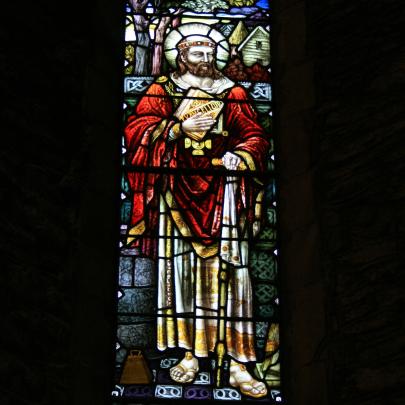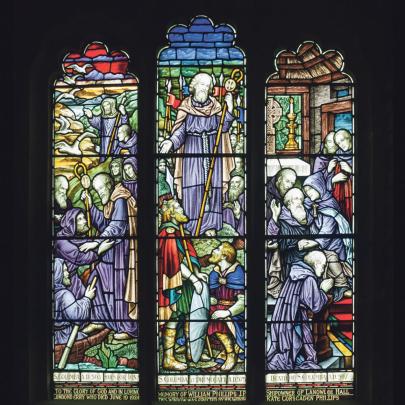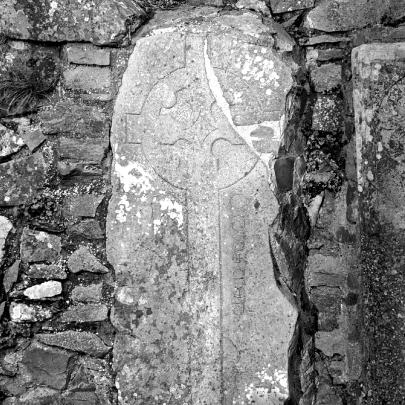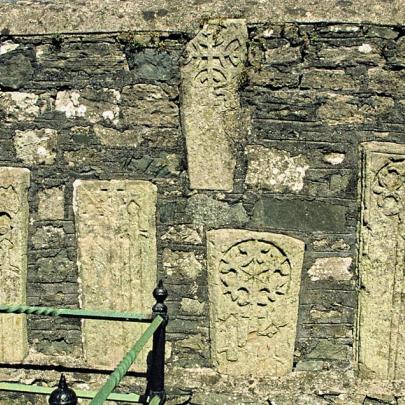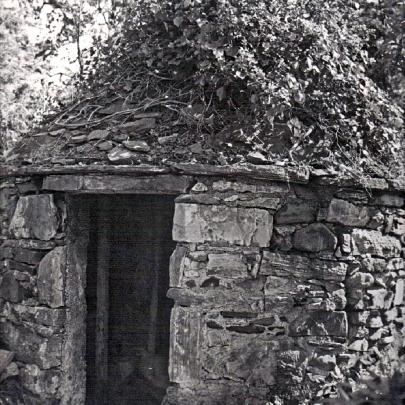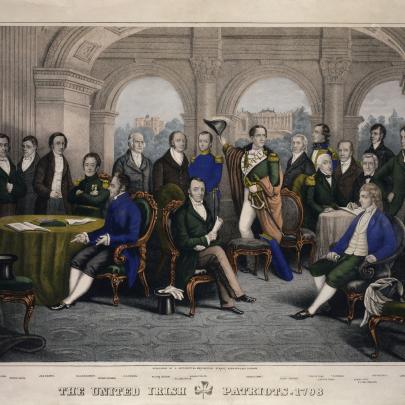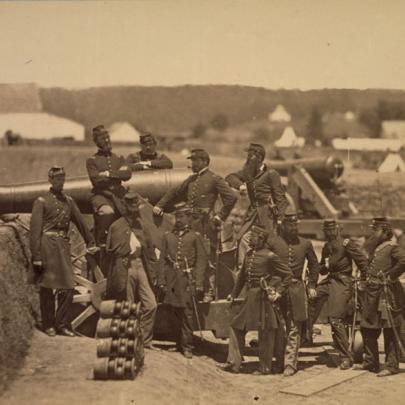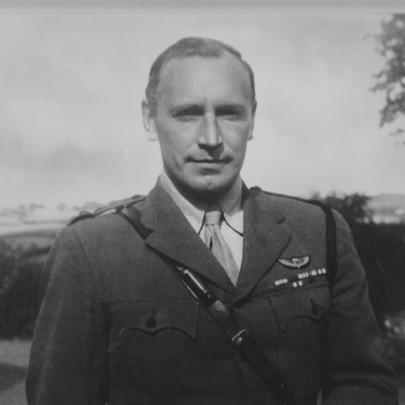Movilla Cemetery
Movilla was founded as Magh-bile, meaning ‘the plain of the sacred tree’ by St. Finian sometime in the 6th century and the site held an important role in Ireland from its foundation.
History of the Site
St Finian and St Columba
Movilla was founded as Magh-bile, meaning ‘the plain of the sacred tree’ by St. Finian sometime in the 6th century and the site held an important role in Ireland from its foundation.
The story of St Finian of Moville (495-589) is that he was born near Strangford Lough in Co Down, that he studied under Saints Colman of Dromore and Mochoe of Noendrum (Mahee Island) and went to Candida Casa (Whithorn) in Scotland, from where he journeyed to Rome. On his return he founded Movilla Abbey.
Tradition maintains that St Columba (also known as Colmcille) studied under Finian. He sat in the scriptorium of this site copying a psalter, which led to the Battle of Ceil-Dreimhe in 561AD. Possibly the earliest known argument over copyright, it was said the two saints quarrelled when Columba copied the manuscript and intended to keep the copy, something which Finian disputed.
The King siding with Finian gave the judgement, "To every cow belongs her calf, therefore to every book belongs its copy." Columba disagreed with the King and reportedly instigated a successful rebellion of the Uí Néill clan against him. The battle was claimed to have caused around 3,000 casualties.
After the battle, as a monk who had taken up arms, Colmcille faced judgement for his deeds. It said that the judgement resulted in Columba leaving his homeland for Scotland, where he founded Iona Abbey in 563. The sentence stipulated he was to win as many souls to Christianity as had been lost in the battle.
Modern historians dispute the story as a cause for the battle, but it is true that Colmcille left and founded Iona Abbey and it is his monks who crafted the Book of Kells held at Trinity College, Dublin.
Vikings, Normans and Tudors
Movilla was plundered by Vikings in the 9th century but was re-founded as an Augustinian abbey in the Norman 12th century and survived until the suppression of religious houses under Henry VIII in the 1530s.
The remains today are of the medieval church. The original structure dates to the 13th century and survives in the east while in the west remains the 15th century extension. However, none of the associated monastic buildings survive. Although the narrow window in the east wall with a semi-circular head possibly dates to the 12th century or an even earlier church. The abbey itself measures 10ft by 20ft internally and has no structural division. Movilla Abbey itself was a substantial building with quite solid walls capable of supporting a first or even second floor. The central part of the north wall with its blocked door was rebuilt in the post-medieval period.
However, the most impressive feature of Movilla Abbey is the interior wall on the west side in which a grave-slab of the Early Christian period and seven 13th century coffin-lids are inserted. The slab is of particular importance as funerary monuments of the Early Christian period are relatively rare in County Down. This example bears a cross design and is inscribed with the Irish ‘or do dertrend’ which translates as ‘a prayer for Dertrend’.
Excavated Evidence
An excavation was conducted at this site in 1981 and subsequently produced excellent evidence of the medieval period. Late Mesolithic, Neolithic and Bronze Age artefacts were found which proves that there was prehistoric occupation but little more of this period was discovered.
The finds from Movilla Abbey once again emphasise the importance of this site in history. Various objects were discovered ranging from domestic tools, such as spindle whorls, whetstones and stone tools, to jewellery for example beads and a lignite bracelet. Tiny fragments of gold-filigree were also located here. Gold working evidence is limited on archaeological sites because the value of this metal makes it too precious to be mislaid or discarded.
At Movilla fragments of twisted glass rod, coloured green, blue or white resembling waste pieces were found suggesting a possible manufacturing site. However, no evidence exists at other sites of bead-making workshops and thus the collection from Movilla has been acknowledged as one of the best from any Early Christian site in Ulster. The glass pieces found are of a type used as decoration such as bangles.
Movilla Abbey has produced extensive evidence of craft activity including large numbers of crucibles and clay moulds as well as trial pieces, also known from Nendrum and Bangor Abbey. There is also evidence of bronze working on this site in the medieval period, indicated by the presence of scrap copper alloy. Another large industry at the abbey was iron preparation and working as large numbers of iron slag (waste) was found on site from the Early Christian and medieval period.
More info re. Rev Archibald Warwick, James Francis and Lt Col. Robert Blair 'Paddy' Mayne DSO
Rev Archibald Warwick (unknown-15/10/1798)
In the Report of the Belfast Presbytery, 1799, it is stated that “Mr. Archibald Warwick who was under the care of the Presbytery (as a student for the Ministry, or as a Probationer), having been found guilty of treason by a military tribunal was executed at Kircubbin in the month of October, 1798. He was attended and comforted in his last hours by Rev Mr. Brydone.”
On 15 October 1798, 29-year-old Archibald Warwick of Kircubbin Presbyterian Church was executed by public hanging. The gallows were raised between the church and the manse, in an area which today is a public car park. Thousands gathered to see him die. This body was laid out on an old oak table which is still preserved in the manse. His crime was his role in the 1798 Rebellion and the attempt to overthrow the government. His family were all from Loughriscouse outside Newtownards and he was buried in the family plot at Movilla Cemetery.
Information from the blog of Mark Thompson - When they hanged Archibald Warwick in Kircubbin
Brief Overview of the 1798 Rebellion
The 1798 rebellion was an insurrection launched by the United Irishmen, an underground republican society, aimed at overthrowing the Kingdom of Ireland, severing the connection with Great Britain and establishing an Irish Republic based on the principles of the French Revolution.
The 1790s marked an exceptional event in Irish history because the United Irishmen were a secular organisation with significant support both among Catholics and Protestants, including Protestants in the northern province of Ulster.
An overview of the insurrection of 1798, by John Dorney
Although 18th Century Ireland had its own Parliament, power was still effectively held by the British Government. Over the course of the century, the Irish Parliament fought for more control. This was somewhat successful; however, membership of the parliament was confined to members of the Anglican Church of Ireland. This meant that most of the population which was composed of Catholics and non-subscribing Protestants (such as Presbyterians) held no power at all.
Under the Penal Laws enacted in the 1690s, Catholics and Presbyterians were barred from parliament, any public position or service in the Army. Catholics also suffered from restrictions on landholding, inheritance, entering the professions and the right to bear arms. Presbyterians marriages performed by their clergy were not legally recognised.
Initially the United Irishmen, founded, mainly by Presbyterians in Belfast in 1791, campaigned merely for reform. Some of their early demands were granted such as Catholics were given the right to vote in 1793, but reform did not go far enough. The group, who were inspired by the French Revolution, were then banned after Britain went to war with France in 1793. They went underground and radicalised. Their new goal was a fully independent Irish Republic.
After a failed invasion with French allies in 1796, the Government in Dublin brought in stringent insurrection laws and by 1798, the United Irishmen felt they had to act. The rebellion was intended to be signalled by the stopping of all mail coaches out of Dublin on May 23, 1798. However, the authorities were aware of the plans and on the eve of the rebellion arrested most of the senior United Irishmen leadership.
With no leadership, the rebellion was doomed to fail. In Ulster, the Battle of Ballynahinch was lost as were other Battles around Ireland. Within three months the rebellion was over. Many United Irishmen leaders were either executed, imprisoned or exiled. As a result of the uprising, the Irish Parliament, which had existed since the 13th century, was abolished and under the Act of Union (1800) Ireland was to be ruled directly from London until 1922.
James Francis (unknown- 1921)
Little is known about the life of James Francis other than the fact he served with the 69th Infantry NY Company in the American Civil War (1860-65) as indicated on his gravestone.
There are two James Francis’s on the roster of the company in the Civil War records. The first was age 20 and enlisted on 26 February 1864 in the 2nd Congressional District (Long Island) to serve 3 years. He was mustered in as a Private in Company A on 9 March 1864 and mustered out with company 30 June 1865 at Alexandria, Virginia.
The second was age 21 and enlisted on 11 October 1864 at Jamaica, Queens to serve 1 year. He was mustered in as a Private, but unassigned to a company. He mustered out on 12 October 1864 and never joined the regiment.
69th Infantry NY Company
The 69th Regiment, located in New York city and still in existence, was founded 21 December 1849 with Company A, 1st Battalion descending from the 8th Company of the New York Regiment of the American Revolutionary War.
It is known as the "Fighting Sixty-Ninth", a name said to have been given by Robert E. Lee during the Civil War and nicknamed the "Fighting Irish", immortalised in Joyce Kilmer's poem ‘When the 69th Comes Home’.
The Regiment began as part of the Irish Revolutionary Movement in reaction to the failed Young Irelander Rebellion of 1848. Irish patriots living in New York City believed they needed an Irish Brigade to free Ireland from Britain. In late 1848, they organized independent military companies in the city and convinced the state to form an Irish regiment from these companies.
In 1860, Michael Corcoran was named Colonel of the 69th. He gained fame and notoriety when he refused to parade the regiment for the visiting Prince of Wales, protesting the British imposition of the Irish Famine. He was placed under arrest, but the charges were dropped when the bombardment of Fort Sumter began the American Civil War.
The Regiment fought in many of the bloodiest battles of the war including Antietam, Fredericksburg, Chancellorsville and Gettysburg. Due to severe losses in the first two battles, following Gettysburg (July 1863), the depleted ranks of the 69th Regiment were filled with new volunteers and draftees from New York's Irish ghettoes.
Information source - ‘New York in the War of the Rebellion’, 3rd ed. Frederick Phisterer. Albany: J. B. Lyon Company, 1912.
Lt Col. Robert Blair 'Paddy' Mayne, DSO
Sporting Talent
Born and raised at the family home in Mount Pleasant in Newtownards, Mayne attended Regent House Grammar School, where his talent for rugby was obvious - playing for the school first XV and Ards RFC.
While at Queen's University in Belfast studying law, he took up boxing and won the Irish Universities heavyweight title in August 1936.
He made his Ireland rugby debut against Wales at Ravenhill in 1937 and was only capped three times before he was selected for the Lions tour to South Africa. The tour lasted over three months, from June to September 1938, encompassing 24 matches. While the Lions lost the Test series 2-1, their victory in the third game was the first Test win for the Lions in seven, a record Test score for them and their first win against South Africa since 1910.
Following the Lions tour Mayne was capped three more times for Ireland, before World War Two brought a premature end to his rugby career.
Second World War
At the outbreak of war, Mayne enlisted in the Royal Ulster Rifles, before joining the commandos and then becoming a founder member of the SAS. From 1941-44, he led many successful raids across the Middle East and Europe.
For his bravery, he won many medals, including the Distinguished Service Order four times, and received a citation for the highest military honour, the Victoria Cross, but was turned down. It is thought that this was due to his disrespectful and sometimes reckless behaviour. His infamous insubordination to his commanding officers did not help. There have been campaigns for the VC to be awarded posthumously, so far without success.
Mayne returned home after the war where he became Secretary to the Law Society of Northern Ireland. Over the ensuing years there were numerous rumours of him getting embroiled in bar fights.
Tragically, he died aged 40 in a road accident in his native Newtownards in 1955.
The Times newspaper published his obituary:
“Lieutenant Colonel Robert Blair Mayne, DSO, was killed yesterday in a motor car accident near his home at Mount Pleasant, Newtownards, County Down.
He was 40. The son of the late William Mayne, he was educated at Regent House School and Queen’s University, Belfast. He played Rugby for Queen’s and was later capped as a forward in six international games between 1936 and 1938, and in the latter year he was a member of the British team which toured South Africa.
He also won the amateur heavyweight boxing championship of Northern Ireland while a student at the university. He qualified as a solicitor, and at the outbreak of war in 1939 joined the Royal Artillery, transferring later to the Royal Ulster Rifles. Later he commanded the Special Air Service, formed by volunteers in North Africa in 1941, the members of which were dropped behind enemy lines.
Helped by the Maquis, Colonel Mayne set up a secret headquarters and had much success in harassing the movement of enemy troops and supplies. He was in command of the unit in 1943 when it was allotted the task of opening the invasion assault on Sicily.
He was awarded the D.S.O. in 1942 and had received three bars before the war was over. In 1945 he flew to the Falkland Islands, where he joined an expedition to the Antarctic.
It was to have lasted two and half years, but in February 1946, he was compelled to relinquish his post as second in command of the expedition because of an injury received while on active service. In 1946 he became secretary of the Incorporated Law Society of Northern Ireland, which he remained until his death. He was unmarried.”
You might also like
Online Arts and Heritage Grant Information Session
-
Between Worlds
-
Observational Acrylic / Oil Painting
-
Outreach Class: Watercolour with Bernice Anderson
-

